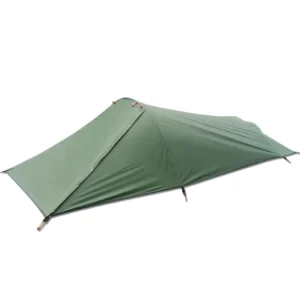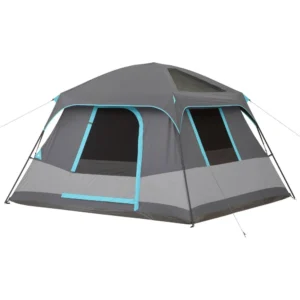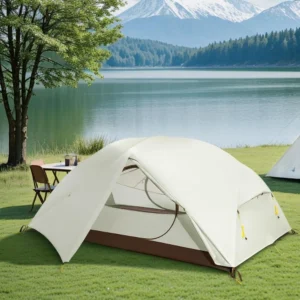1. The Benefits of Compact Shelters for Camping Duos
For camping pairs seeking adventure without excess baggage, compact shelters offer the perfect solution. These shelters—typically weighing under 5 pounds and packing smaller than a standard backpack—provide freedom that traditional, bulkier options simply can’t match.
The advantages of choosing a compact shelter for two extend far beyond just saving space:
- Enhanced mobility: Lighter loads mean longer hikes with less fatigue
- More destination options: Access remote campsites that would be impractical with heavier gear
- Minimal environmental impact: Smaller footprints disturb less of the natural area
- Simplified travel: Easily fit your shelter in a backpack, motorcycle saddlebag, or small vehicle
- Closer connection to nature: Less material between you and the outdoors enhances the wilderness experience
When comparing standard and compact options, the difference becomes clear—while conventional two-person tents might pack down to approximately 18×7 inches and weigh 6-8 pounds, today’s compact alternatives can compress to just 12×5 inches and weigh half as much.
Throughout this guide, we’ll explore how to select the perfect compact shelter that balances your need for portability with comfort, protection, and durability. Comprehensive understanding of the ultimate guide to compact shelters for two campers ensures you’ll find the ideal balance for your outdoor adventures. Whether you’re weekend warriors or extended expedition enthusiasts, the right compact shelter awaits.
2. Understanding Your Duo’s Camping Style and Needs
Before diving into specific shelter options, take time to assess your unique camping partnership. Your relationship dynamics significantly influence which shelter will work best for your adventures together.
Relationship Dynamics
Different duos have different spatial needs. Romantic couples often tolerate closer quarters than platonic friends, while parent-child teams might prioritize ease of setup over extreme weight savings. Consider how comfortable you are with minimal personal space and shared sleeping arrangements.
Primary Camping Activities
Your typical adventures directly impact your shelter requirements:
- Backpacking: Emphasizes ultralight materials and minimal packed size
- Bikepacking: Demands exceptionally compact packed dimensions that fit on handlebars or frame bags
- Mountaineering: Requires robust weather protection and structural stability
- Paddling trips: Benefits from quick-drying materials and simplified setup
Trip Duration and Frequency
Weekend warriors might happily sacrifice some comfort for weight savings, while those embarking on week-long journeys typically need more livable space and durability. Similarly, if you camp frequently, investing in higher-quality materials makes economic sense over time.
Weather Conditions
Be honest about where and when you’ll be camping. Desert environments demand excellent ventilation, while rainforests require superior waterproofing. High-altitude destinations need stronger materials and wind resistance, and multi-season adventurers should consider versatile shelters that adapt to changing conditions.
Priority Trade-offs
Every shelter decision involves compromises:
* Weight vs. space
* Setup speed vs. weather protection
* Durability vs. cost
* Simplicity vs. features
Discussing these priorities with your camping partner before shopping ensures you’re both aligned on what matters most. Understanding various camping shelter options for two helps you navigate these trade-offs with confidence.
3. Types of Compact Shelters for Two Campers
Selecting the right shelter type forms the foundation of your camping comfort. Each design offers distinct advantages for camping duos.
Double-Wall Tents
These traditional tent designs feature an inner mesh body with a separate rainfly.
| Pros | Cons |
|---|---|
| Excellent ventilation | Heavier than other options |
| Superior condensation management | More complex setup |
| Versatile (can use inner tent alone in dry weather) | Larger packed size |
| Bug protection | More pieces to potentially lose |
Best for: Campers prioritizing comfort and versatility across varied conditions.
Single-Wall Tents
These simplified designs combine the rainfly and tent body into a single layer.
| Pros | Cons |
|---|---|
| Significantly lighter | Increased condensation issues |
| Faster setup | Less breathability |
| Smaller packed size | Often less interior space |
| Fewer parts to manage | Limited vestibule options |
Best for: Weight-conscious backpackers traveling in moderate conditions.
Tarp Systems
Minimalist setups using a waterproof fabric pitched with trekking poles, trees, or dedicated poles.
| Pros | Cons |
|---|---|
| Ultralight (often under 2 pounds) | Limited bug protection (unless paired with net) |
| Highly customizable pitching options | Less privacy |
| Excellent ventilation | Requires more skill to set up effectively |
| Often the smallest packed size | Ground exposure requires careful site selection |
Best for: Experienced minimalists comfortable with weather assessment and creative setups.
Hammock Setups
Suspended systems that lift you off the ground entirely.
| Pros | Cons |
|---|---|
| No need for level ground | Requires appropriate trees or anchor points |
| Excellent comfort on soft surfaces | Dual hammock systems can be complex |
| Great airflow | Less suitable for cold weather without additional insulation |
| Minimal ground impact | Limited cuddle factor for couples |
Best for: Forest campers seeking comfort in areas with unreliable ground conditions.
Bivy Systems
Ultra-minimal personal shelters sometimes viable for two with creative configurations.
| Pros | Cons |
|---|---|
| Lightest possible option | Very limited living space |
| Smallest packed size | Minimal weather protection |
| Quick setup | Claustrophobic for many users |
| Good emergency backup | Virtually no room for gear storage |
Best for: Ultralight enthusiasts on short trips or as emergency shelter options.
The selection of 2-person camping tents continues to evolve with innovative designs. When making your selection, consider how each shelter type impacts your ability to maximize space and comfort in ultralight shelters during your adventures.
4. Critical Weight and Size Considerations for Duos
When selecting a compact shelter, understanding weight terminology prevents unpleasant surprises on the trail.
Trail Weight vs. Packed Weight
- Trail Weight: Includes only essential components (tent body, rainfly, poles)—typically 20-30% less than packed weight
- Packed Weight: Everything that comes with the shelter (including stakes, stuff sacks, repair kits, instructions)
For duo camping, the practical weight you’ll carry likely falls between these measurements. Focus on trail weight for comparative shopping, but understand the full packed weight when planning your load.
Realistic Packed Size Expectations
For true compact shelters suitable for two, look for these approximate packed dimensions:
* Premium ultralight options: 12×5 inches (30×13 cm)
* Mid-range compact options: 16×6 inches (41×15 cm)
* Budget-friendly compact options: 18×7 inches (46×18 cm)
Remember that longer packed lengths can be challenging to fit horizontally in backpacks, often requiring vertical placement that affects weight distribution.
Material Impact on Weight
Fabric thickness (measured in denier) dramatically affects both weight and durability:
* 10-20D: Ultralight but requires careful handling
* 30-40D: Good balance for most users
* 50D+: Significantly more durable but heavier
Similarly, pole materials matter:
* DAC Aluminum: Industry standard balancing weight and strength
* Carbon Fiber: Premium ultralight option (but less durable)
* Fiberglass: Budget-friendly but substantially heavier
Weight Distribution Strategies
One significant advantage of duo camping is the ability to split shelter components:
* One person carries poles and stakes
* One person carries tent body and rainfly
* Alternate carrying responsibilities on multi-day trips
Determining precisely how much a backpacking tent should weigh depends on your specific needs and priorities, but most duos find that 2-4 pounds (0.9-1.8 kg) total represents the sweet spot between comfort and portability.
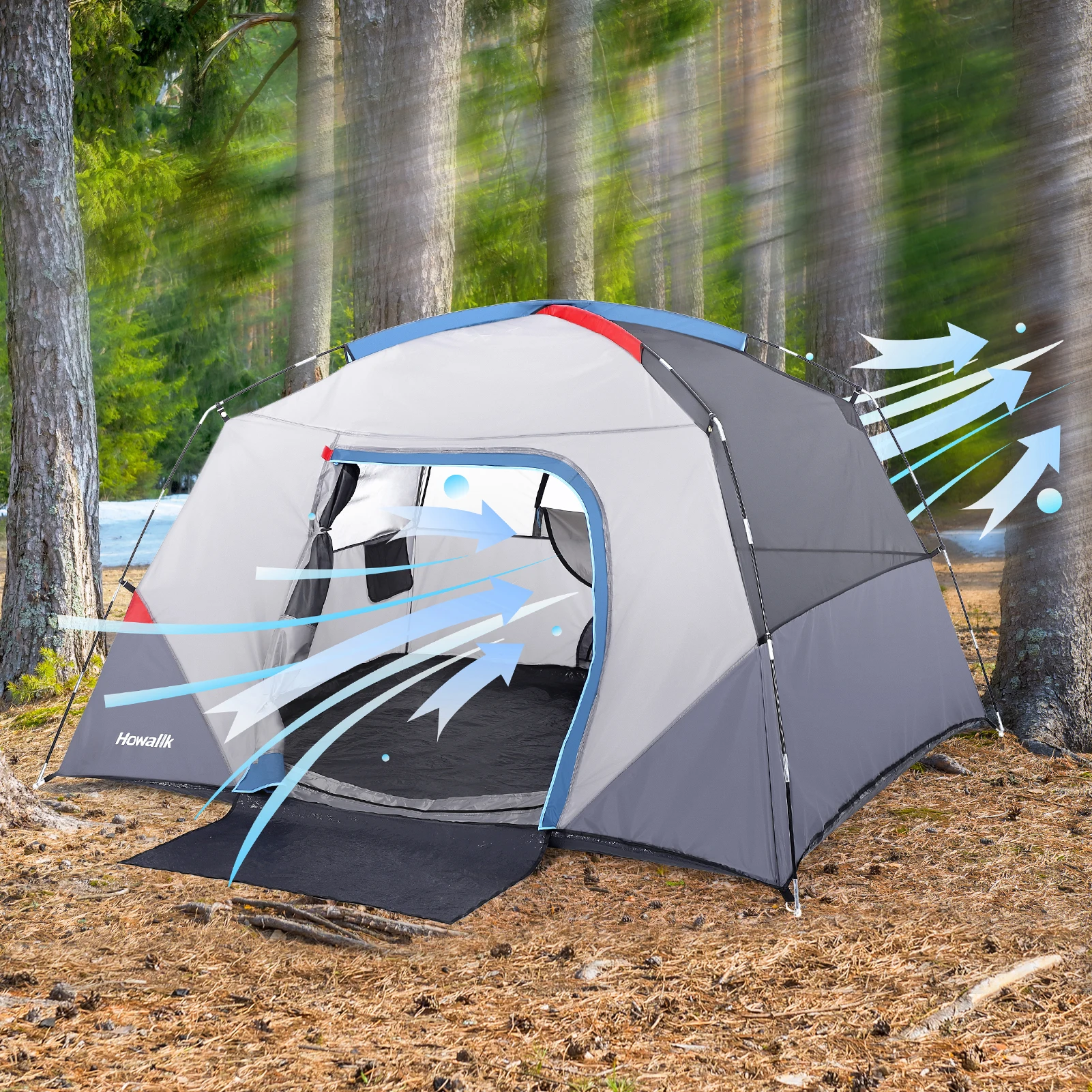
5. Interior Space and Comfort: Finding the Right Balance
When shelter manufacturers label a tent as “2-person,” their definition often means “two people can physically fit inside”—not necessarily comfortably. Understanding true spatial needs prevents disappointment in the backcountry.
Floor Dimensions and Comfort Reality
Standard two-person tents typically offer 28-32 square feet (2.6-3.0 m²) of floor space. For context, two standard sleeping pads (20×72 inches/51×183 cm each) require approximately 20 square feet (1.86 m²) when placed side by side—leaving precious little room for gear.
For genuine comfort, look for:
* Width: At least 50-52 inches (127-132 cm)
* Length: Minimum 86-90 inches (218-229 cm)
* Floor area: 30+ square feet (2.8+ m²)
Peak Height and Wall Angles
The vertical space in your shelter dramatically impacts comfort. Look beyond simple peak height measurements and consider:
- Wall steepness: Near-vertical walls create more usable space than sharply angled ones
- Peak height location: Centered peaks maximize usable sitting space for both occupants
- Headroom at seated position: At least 38-40 inches (96-102 cm) for comfortable changing and in-tent activities
Industry Sizing Standards
Many experienced campers follow this rule of thumb: Size up one person for genuine comfort. What manufacturers market as a two-person shelter often works better as a spacious one-person option with gear storage. When true two-person comfort matters, consider “2+” or “3-person” models that remain relatively compact.
Dual Doors and Vestibules
These features dramatically improve the duo camping experience:
* Eliminate climbing over your partner for midnight bathroom breaks
* Create dedicated storage space for each person’s gear
* Improve ventilation options in various conditions
* Allow for individual entry/exit without disturbing your partner
The question of whether a 2-person tent is actually big enough depends heavily on your relationship and comfort expectations. Understanding what size tent is good for 2 people helps you establish realistic space requirements for your adventures together.
6. Weather Protection and Seasonal Capabilities
Your shelter represents your primary defense against the elements. Understanding protection ratings ensures you’re never caught unprepared.
Waterproof Ratings Explained
Waterproofing is measured using hydrostatic head ratings, indicating how much water pressure a fabric can withstand before leaking:
- 1,200-1,500mm: Minimum for light rain protection
- 2,000-3,000mm: Standard for three-season use
- 3,000-5,000mm: Premium protection for sustained heavy rain
- 5,000mm+: Expedition-grade protection
For floor materials, look for ratings 1,000-2,000mm higher than the rainfly, as ground pressure increases water penetration risk.
Wind Resistance Evaluation
Wind performance depends more on design than materials:
- Dome structures: Superior stability in high winds
- Multiple crossing poles: Better than single-hoop designs
- Low-profile shapes: Less surface area for wind to catch
- Guy-out points: More attachment points equal better stability
Remember that proper setup substantially impacts wind performance—practice before facing challenging conditions.
Seasonal Shelter Categories
- 3-Season Shelters: Designed for spring through fall, with good ventilation and moderate weather protection (most compact options fall here)
- Extended Season: Enhanced protection for early winter or late fall with stronger poles and reduced mesh
- 4-Season: Full winter protection with robust materials, minimal mesh, and snow-shedding designs (rarely compact or lightweight)
Ventilation for Two Occupants
Two bodies produce significantly more moisture through respiration and perspiration than one. Prioritize:
- Multiple adjustable vents
- Dual doors for cross-ventilation
- Upper mesh panels
- Vestibule ventilation options
Without adequate airflow, condensation becomes a significant issue, potentially soaking sleeping bags and gear. Waterproof backpacking tents with thoughtful ventilation systems provide the best protection against both external precipitation and internal moisture buildup.
7. Durability and Material Considerations for Duo Use
Two campers inevitably place more stress on a shelter than one. Understanding materials helps you balance durability against weight savings.
Fabric Technology Overview
Modern shelter fabrics balance strength, weight, and waterproofing:
- Nylon: Most common tent material, offering good strength-to-weight ratio
- Silicone-coated (silnylon): Enhanced water resistance and durability
PU-coated: Budget-friendly waterproofing option
Polyester: Less stretching when wet, better UV resistance
- **Slower to deteriorate in sunlight than nylon
**Maintains taut pitch in wet conditions
Dyneema/Cuben Fiber: Ultra-premium, extremely lightweight and waterproof
- **Significantly more expensive
- **Excellent strength-to-weight ratio
- **Limited stretch can make pitching more demanding
Understanding Fabric Denier
Lower denier numbers indicate thinner, lighter fabrics:
- 7-10D: Ultra-ultralight, requires meticulous care
- 15-20D: Common in premium lightweight shelters
- 30D: Good balance of weight and durability
- 40-70D: Robust materials for floor and high-wear areas
For two campers, floors below 30D typically require supplemental protection like a footprint or groundsheet.
Pole Materials and Construction
- Aluminum: Standard for quality tents, balancing strength and weight
- DAC Featherlite: Premium aluminum offering weight savings
7000-series: Stronger than 6000-series aluminum
Carbon Fiber: Ultra-lightweight option at premium price
- **Less durable under lateral stress
**Can catastrophically fail rather than bend
Fiberglass: Budget option found in entry-level tents
- **Significantly heavier
- **Less durable over time
- **More prone to breaking under stress
Reinforcement Points
For two-person use, check for:
* Reinforced stake-out points
* Bartacked stress points where poles insert
* Robust zippers (YKK recommended)
* Sealed or taped seams
Quality ultralight 2-person tents balance minimal weight with strategic reinforcement at high-stress points, ensuring durability without unnecessary weight.
8. Setup and Stability: Essential Factors for Camping Partners
Your shelter’s setup process significantly impacts your camping experience, especially after long days on the trail or in challenging weather conditions.
Shelter Design Types
- Freestanding:
- Sets up completely without stakes
- Easier to reposition after initial setup
- Simpler on challenging surfaces (rock, sand, snow)
Generally heavier due to complete pole structure
Semi-freestanding:
- Main structure stands independently
- Requires some staking for full tension
- Good compromise between stability and convenience
Popular in modern lightweight designs
Non-freestanding:
- Relies entirely on stakes and tension for structure
- Typically lighter than other designs
- More challenging in difficult ground conditions
- Requires more skill and practice
Evaluating Setup Complexity
When considering a shelter’s setup process, assess:
- Number of connection points and pole segments
- Color-coding or intuitive design elements
- Single vs. multi-piece setup
- Whether it can be set up by one person if necessary
The average setup time ranges from 1-2 minutes for simple tarp configurations to 5-8 minutes for complex double-wall tents. Mastering two-person lightweight tent setup techniques can dramatically improve efficiency when working together.
Partner Setup Strategies
Efficient two-person setup techniques include:
* Designated roles (one handles poles while other manages stake-out)
* Inside/outside assignments (one works inside, one outside)
* Sequential responsibilities (lead person handles initial structure, partner completes details)
With practice, duo teams can often set up shelters significantly faster than solo campers.
Terrain Adaptability
Consider how your shelter adapts to:
* Limited staking options (rock platforms, sandy beaches)
* Uneven or sloped terrain
* Confined spaces between trees or obstacles
* Exposure to prevailing winds
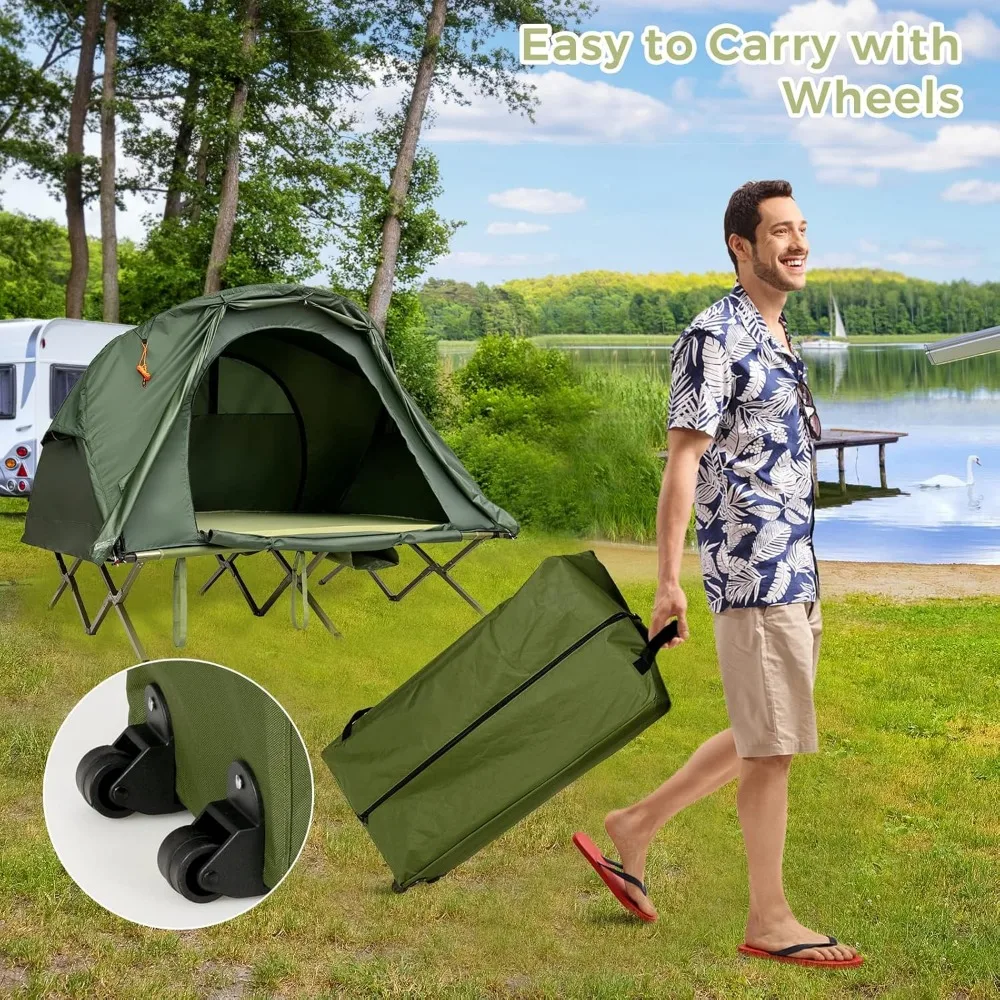
9. Practical Selection Process: How to Make Your Final Decision
With numerous options available, following a structured decision process helps narrow your choices efficiently.
Create Your Priority Matrix
Start by ranking these factors from most to least important for your specific needs:
1. Weight and packed size
2. Weather protection level
3. Interior space and comfort
4. Setup simplicity
5. Durability expectations
6. Budget constraints
7. Vestibule/storage requirements
This personalized ranking ensures you focus on what matters most to your duo.
Research Methodology
Effective research combines multiple information sources:
* Professional gear reviews from outdoor publications
* User reviews focusing on those with similar usage patterns
* Manufacturer specifications and design philosophy
* Hands-on testing whenever possible
Be particularly attentive to feedback from users with similar build, camping style, and destinations as yours.
Pre-Purchase Testing Options
Before committing to a specific shelter:
* Visit outdoor retailers to set up display models
* Rent similar designs for weekend trips
* Borrow from fellow outdoor enthusiasts
* Attend demonstration events by manufacturers or retailers
Nothing replaces the value of crawling in, sitting up, and laying down in a shelter before purchase.
Value Assessment Beyond Price
Calculate long-term value using:
* Cost per anticipated night of use
* Warranty coverage and support
* Repair options and parts availability
* Resale value of premium brands
A higher initial investment often translates to better long-term economics and experience. Best compact shelters for two often represent thoughtful compromises between competing priorities rather than excelling in a single category.
Lightweight Backpacking Tent, Ultralight Backpacking Tent, Ultralight Bivy Tent
Ultralight Single Person Camping Tent with Aluminum Poles for 3-Season Backpacking Waterproof DesignPrice range: $94.88 through $326.82 Select options This product has multiple variants. The options may be chosen on the product pageTall / Stand Up Camping Tent, Two Room Camping Tent
$407.93 Select options This product has multiple variants. The options may be chosen on the product pageLightweight Backpacking Tent, Ultralight Backpacking Tent, Waterproof Backpacking Tent
$391.05 Select options This product has multiple variants. The options may be chosen on the product pageCompact Backpacking Tent, Lightweight Backpacking Tent, Waterproof Camping Tent
$335.52 Select options This product has multiple variants. The options may be chosen on the product pageUltralight Backpacking Tent, Ultralight Dome Tent, Winter Camping Tent
Price range: $369.63 through $370.07 Select options This product has multiple variants. The options may be chosen on the product pageCamping Tent with Vestibule, Waterproof Camping Tent
Price range: $407.89 through $479.48 Select options This product has multiple variants. The options may be chosen on the product page
10. Care and Maintenance for Extended Shelter Life
Proper maintenance dramatically extends your compact shelter’s lifespan and maintains its performance characteristics.
Field Care Essentials
Implement these practices during every trip:
* Clear ground debris before setup to prevent punctures
* Avoid prolonged UV exposure when possible
* Never store wet (even briefly between consecutive nights)
* Use footprints or groundsheets under thin floors
* Remove boots before entering
* Be gentle with zippers, using two hands when operating
Cleaning Techniques
Different materials require specific cleaning approaches:
* Nylon/Polyester: Gentle hand washing with non-detergent soap
* Silnylon/Silpoly: Avoid soaps that can degrade silicone coating
* Mesh: Extra care when removing debris to prevent tears
* Poles: Rinse with fresh water, especially after exposure to sand or salt
Never machine wash or dry your shelter unless specifically recommended by the manufacturer.
Storage Best Practices
Between adventures:
* Ensure shelter is completely dry before long-term storage
* Store loosely, not compressed in stuff sack
* Keep in cool, dry environment away from direct sunlight
* Consider using storage-specific sacks (typically larger than stuff sacks)
* Periodically air out during extended storage periods
Common Repairs
Share these maintenance responsibilities between partners:
* One person inspects while the other repairs
* Develop complementary repair skills
* Create a shared kit with appropriate patches, seam sealer, and pole splints
Small field repairs addressed promptly prevent catastrophic failures on future trips. Freestanding backpacking tents often require less maintenance than non-freestanding alternatives but benefit equally from proper care routines.
11. Can Two People Really Be Comfortable in a Compact Shelter?
While compact shelters inevitably involve some compromise, thoughtful selection and usage strategies can create surprisingly comfortable accommodations.
Setting Realistic Expectations
The key to happiness in compact shelters is appropriate expectations. Understand that:
* You will have less personal space than at home
* Organization becomes essential, not optional
* Some contact with your partner is inevitable
* Weather affects comfort perception dramatically
Space Optimization Strategies
Maximize limited square footage with these techniques:
* Use compression sacks for clothing and sleeping bags
* Establish dedicated storage zones for each person
* Utilize vestibule space effectively for gear and cooking
* Consider ultralight alternatives to bulky gear
Sleeping Arrangements
For maximum comfort:
* Use rectangular pads instead of tapered for more usable space
* Consider wide pads (25”) if sleeping position flexibility matters
* Align sleeping bags with same-side zippers for couple-friendly use
* Use pack liners or stuff sacks for pillows rather than bringing dedicated ones
Personal Space Considerations
Even minimal shelters can provide psychological comfort through:
* Consistent sides/areas for each person
* Headlamp hooks for individual lighting
* Small mesh pockets for personal items
* Agreed-upon changing protocols
The question of finding your perfect space-saving tent for two depends heavily on your relationship dynamics and comfort with proximity. Many couples and close friends find the shared experience enhances rather than detracts from their outdoor adventures.
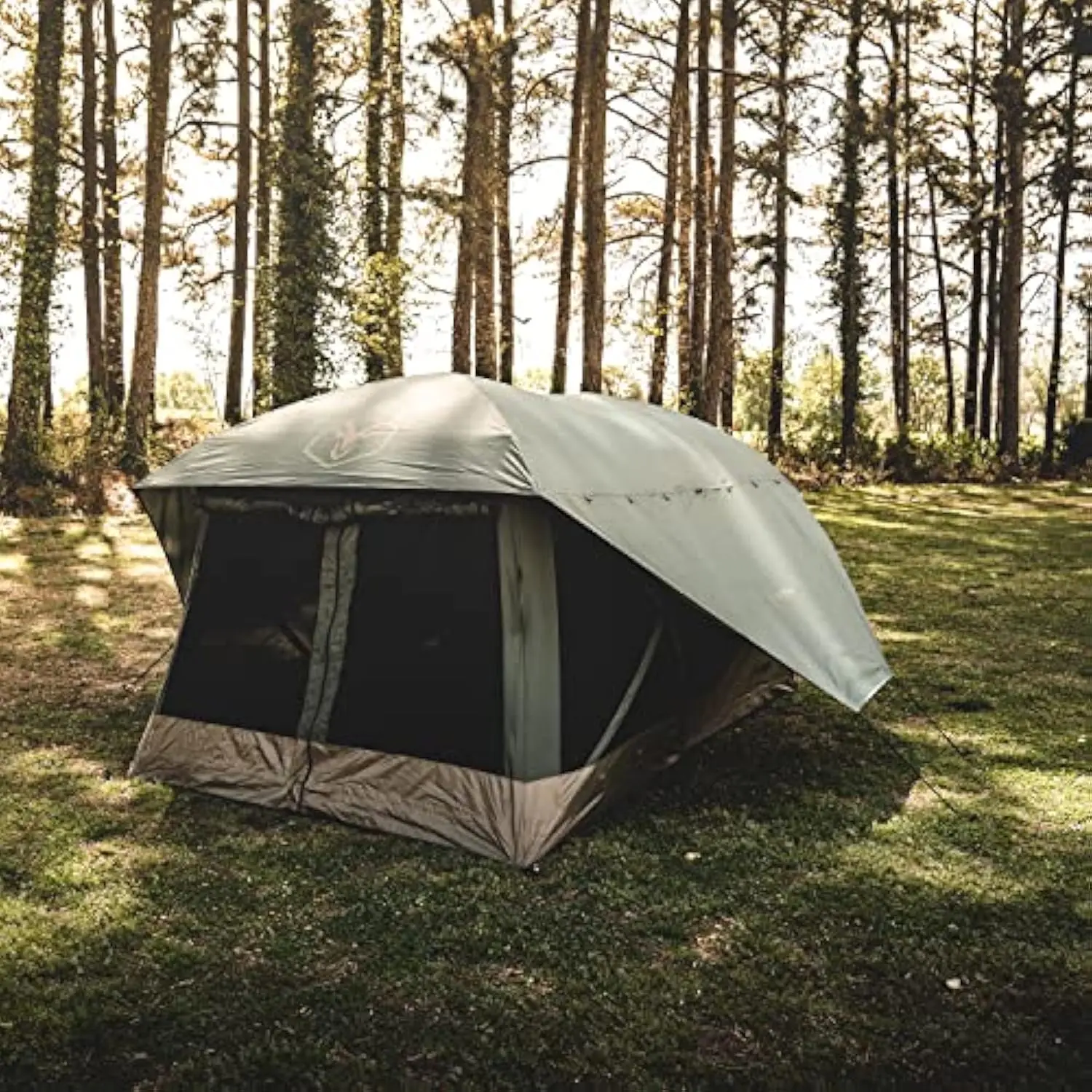
12. Is a Higher Price Always Worth It for Compact Shelters?
The wide price range for compact two-person shelters—from under $100 to well over $500—raises legitimate questions about value and diminishing returns.
Value Analysis Across Price Points
Different price ranges deliver distinct benefits:
- Budget ($100-200):
- Functional protection in moderate conditions
- Heavier materials (5+ pounds typical)
- Limited warranty support
Shorter expected lifespan
Mid-range ($200-350):
- Significant weight reduction (3-4 pounds)
- Enhanced weather protection
- Better ventilation systems
- More livable designs
Reasonable durability
Premium ($350-500+):
- Ultra-lightweight materials (2-3 pounds)
- Superior weather resistance
- Extended durability despite lighter materials
- Refined details and features
- Excellent warranty support
Justifiable Premium Features
Certain higher-cost features deliver tangible benefits worth considering:
* DAC Featherlite NSL poles (significant weight savings with strength)
* Custom or proprietary fabrics with enhanced waterproofing
* Advanced ventilation systems that minimize condensation
* Optimized geometries that maximize livable space
* Streamlined, toolless field repair options
Diminishing Returns Threshold
Most users find the sweet spot in the mid-to-upper mid-range, where significant performance improvements justify moderate price increases. Beyond approximately $450, improvements become incremental rather than transformative for most users.
Usage-Based Value Calculation
Consider your investment through the lens of frequency:
* Weekend warriors (5-10 nights annually): Mid-range often sufficient
* Regular adventurers (15-25 nights): Premium features become more justifiable
* Dedicated enthusiasts (30+ nights): High-end options deliver best long-term value
Lightweight backpacking tents at various price points offer different balances of features. The best value isn’t necessarily the cheapest option but rather the one that most effectively meets your specific needs at the lowest possible weight and packed size.
At Explore Elements, we believe that investing in quality gear that lasts for years ultimately delivers better experiences and greater value than repeatedly replacing inferior equipment. Your compact shelter forms the foundation of countless memorable adventures—choose wisely and it will serve you faithfully through many journeys together.


